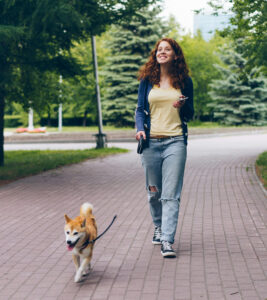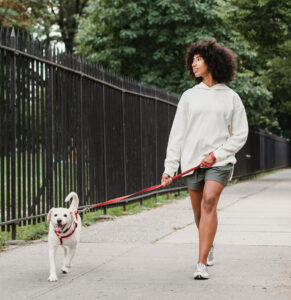
Walking your dog is one of the simplest yet most rewarding ways to bond with your furry friend. It’s more than just a physical activity; it’s a time to nurture their mental health and provide the exercise they need for a happy, healthy life. However, not everyone knows how to walk a dog correctly or follows the best dog walking practices. If you’re looking for dog walking safety tips and tricks, you’re in the right place. This article will guide you through everything you need to know about the right way to walk your dog.

Why Walking Your Dog Is Important
Before diving into tips and tricks, let’s discuss why walking your dog is essential. Regular walks offer numerous benefits:
- Physical Health: Walking keeps your dog’s weight in check and strengthens their muscles, bones, and cardiovascular system.
- Mental Stimulation: New sights, sounds, and smells enrich your dog’s mind, reducing boredom and destructive behaviors.
- Behavioral Benefits: Dogs that get regular exercise are often better behaved because they’re less likely to have pent-up energy.
- Bonding Time: Walking strengthens the bond between you and your pet, fostering trust and companionship.
Best Dog Walking Practices
To ensure a pleasant experience for both you and your dog, follow these best dog walking practices:
- Choose the Right Equipment
- A well-fitting collar or harness is crucial for your dog’s comfort and safety.
- Use a leash appropriate for your dog’s size and strength. Retractable leashes can be useful but are not suitable for every situation.
- Set a Routine
- Dogs thrive on routine. Walk them at the same times each day to establish a predictable schedule.
- Morning and evening walks are ideal, as temperatures are usually more comfortable.
- Warm-Up Period
- Allow your dog a few minutes to sniff and relieve themselves before starting the walk. This helps them focus on the walk itself.
How to Walk a Dog Correctly

Knowing how to walk a dog correctly involves more than just holding a leash. Here are some practical tips:
- Keep the Leash Short but Relaxed
- A short leash gives you better control, especially in busy areas. However, it shouldn’t be so tight that it causes tension.
- Walk at a Steady Pace
- Maintain a consistent pace that suits your dog’s breed, age, and energy level. For energetic breeds, a brisk walk or jog may be ideal, while older dogs may prefer a leisurely stroll.
- Stay on Your Side
- Teach your dog to walk on your left or right side consistently to avoid confusion.
- Reward Good Behavior
- Use treats or praise to reinforce positive behaviors, such as walking calmly or ignoring distractions.
Dog Walking Tips for Different Scenarios
- Walking in Urban Areas
- Be mindful of traffic and use crosswalks.
- Avoid letting your dog sniff or eat anything off the ground, as it could be harmful.
- Walking in Parks or Trails
- Keep your dog on a leash unless in designated off-leash areas.
- Always pick up after your dog to maintain cleanliness.
- Walking Multiple Dogs
- Use a leash splitter for better control.
- Ensure all dogs are compatible in terms of energy and behavior.
Dog Walking Safety Tips

Safety should always be a priority when walking your dog. Here are some essential dog walking safety tips:
- Check the Weather
- Avoid walking your dog during extreme heat or cold. Hot pavement can burn their paws, and freezing temperatures can lead to frostbite.
- Use Reflective Gear
- If you walk your dog early in the morning or late at night, wear reflective clothing and use a leash with reflective strips to stay visible.
- Stay Hydrated
- Bring water for both you and your dog, especially during long walks.
- Be Alert
- Keep an eye out for potential hazards such as broken glass, aggressive dogs, or cyclists.
- Know Your Dog’s Limits
- Pay attention to signs of exhaustion or overheating. If your dog starts panting excessively or seems lethargic, take a break.
Addressing Common Challenges
Even experienced dog owners face challenges during walks. Here’s how to tackle some common issues:
- Pulling on the Leash
- Stop walking as soon as your dog starts pulling. Resume only when they calm down.
- Use a no-pull harness if the behavior persists.
- Chasing After Distractions
- Practice commands like “leave it” or “stay” to manage distractions.
- Stay calm and redirect your dog’s focus with treats or toys.
- Fearful or Anxious Behavior
- Gradually expose your dog to new environments to build their confidence.
- Consult a professional trainer if the anxiety persists.
Making Walks Enjoyable
Walking your dog should be enjoyable for both of you. Here are some ways to make walks more fun:
- Change Routes
- Explore different paths to keep things exciting and stimulate your dog’s curiosity.
- Interactive Activities
- Incorporate games like fetch or hide-and-seek during the walk.
- Socialization Opportunities
- Allow your dog to interact with other friendly dogs when appropriate.
Final Thoughts

Walking your dog is more than a daily chore; it’s an opportunity to improve their health, happiness, and behavior while strengthening your bond. By following these dog walking tips, practicing how to walk a dog correctly, and prioritizing safety, you can ensure every walk is a positive experience. Whether you’re strolling through the neighborhood or adventuring on a scenic trail, these best dog walking practices will help you and your furry friend enjoy the journey together.
The Benefits of Walking Your Dog
How to Keep Your Pet Healthy and Happy: A Comprehensive Guide
Pets bring immense joy to our lives, offering companionship, love, and often a bit of comic relief. Here Are 8 Tips This article Will Cove. 1. Nutrition: The Foundation of Health 2. Regular Exercise and Mental Stimulation 3. Veterinary Care: Prevention is Key 4....


0 Comments